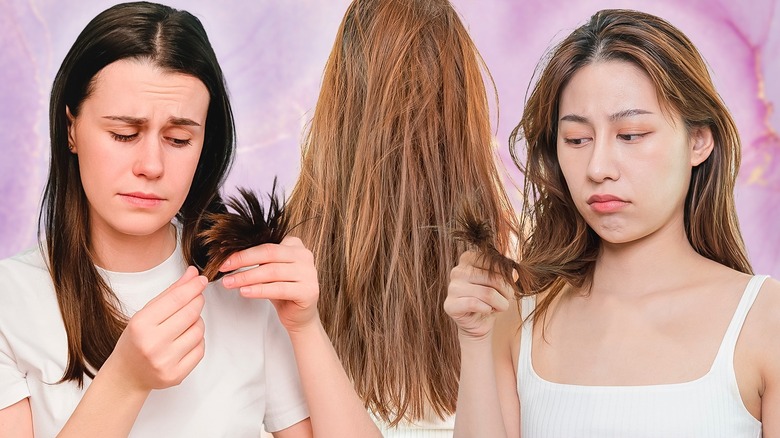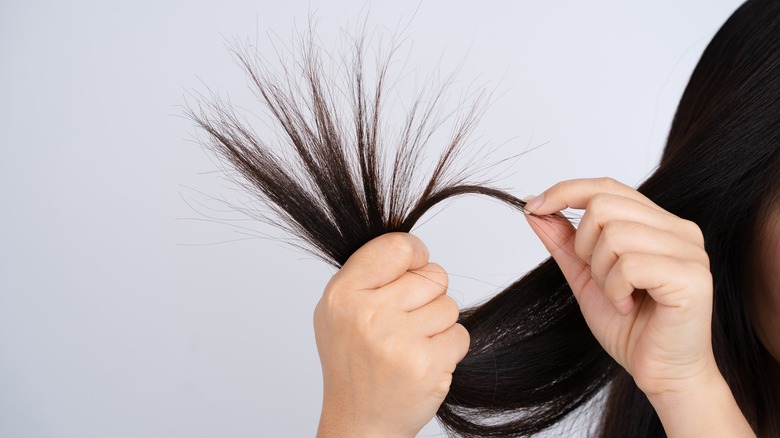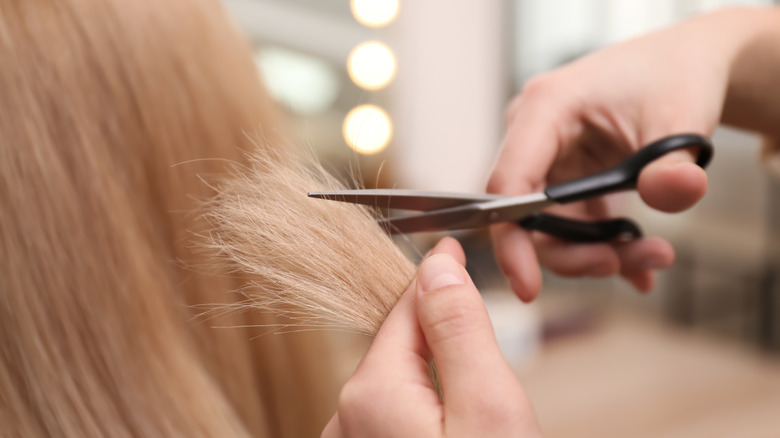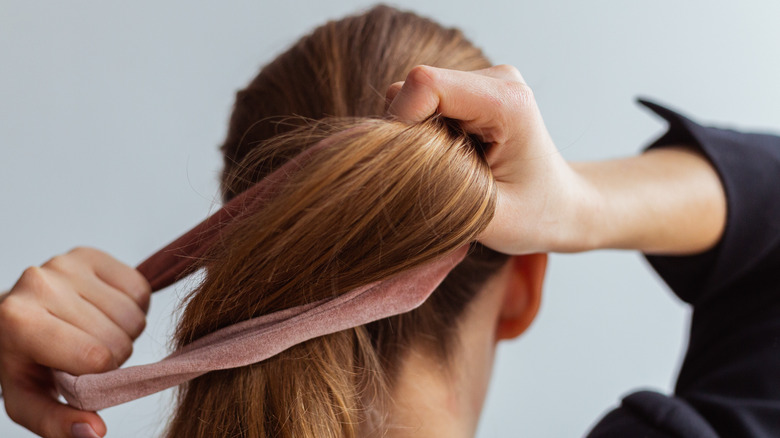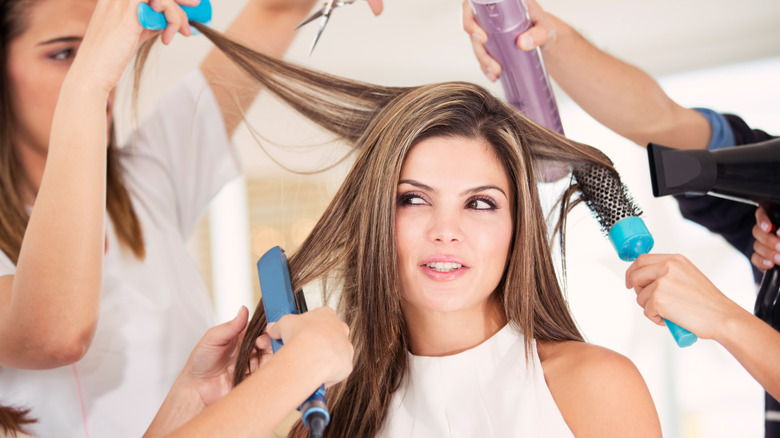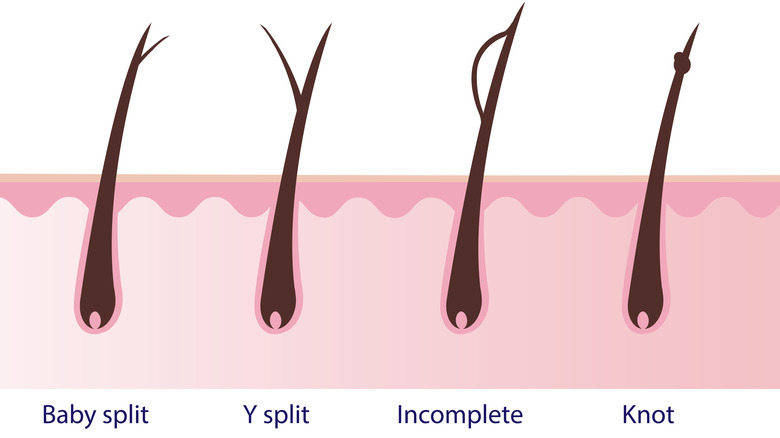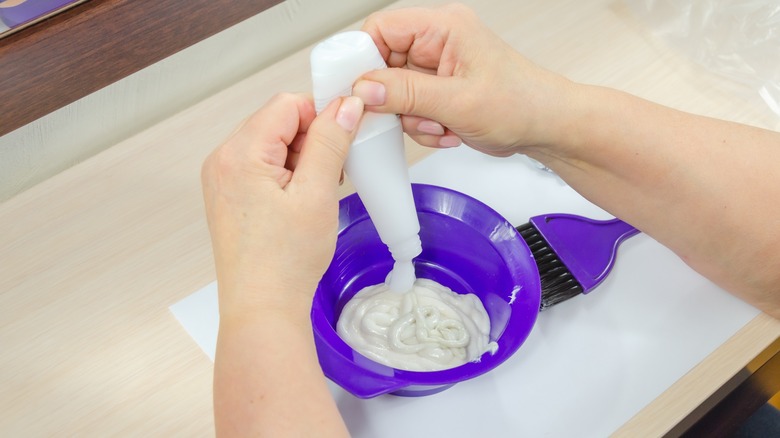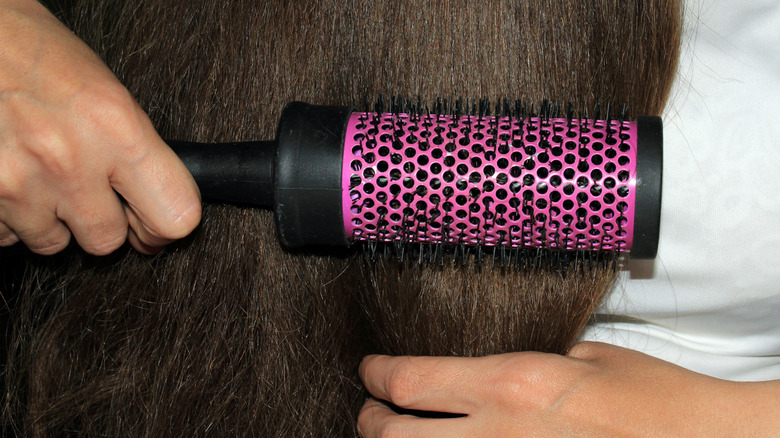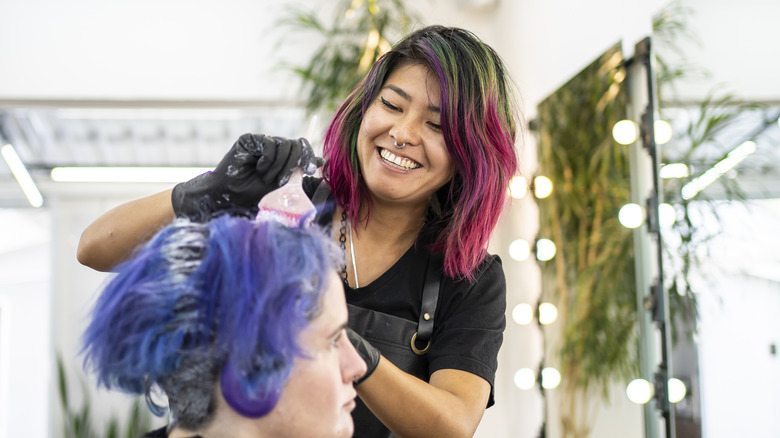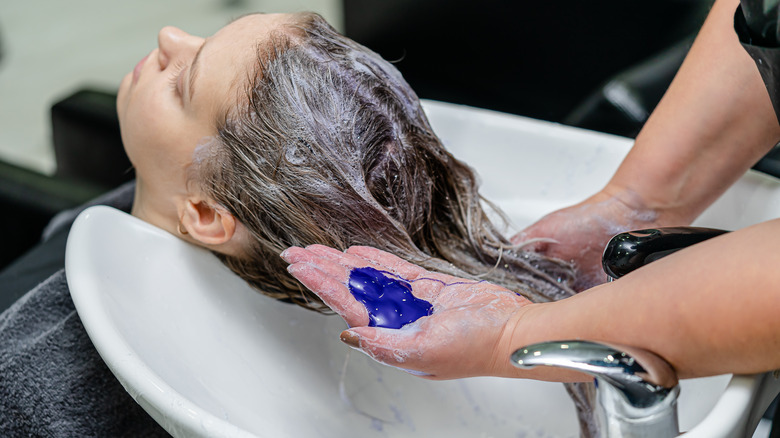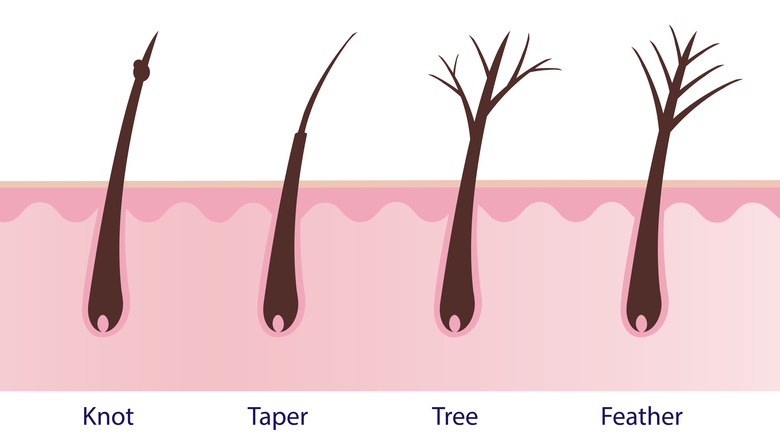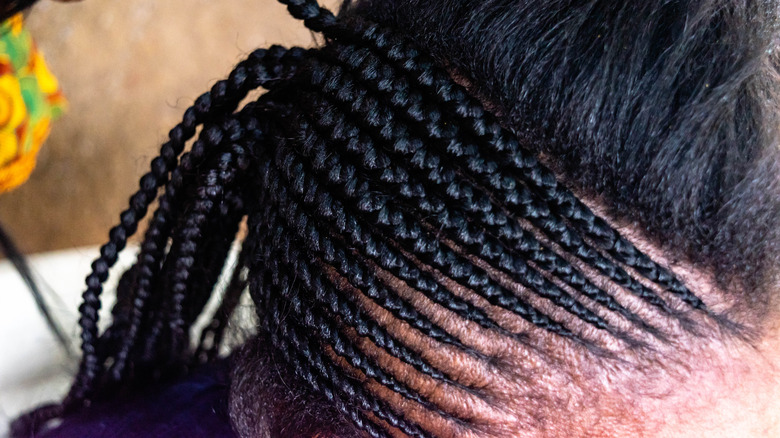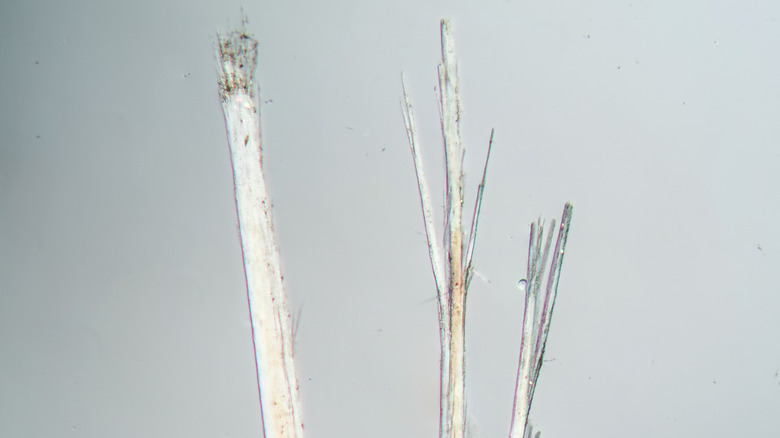Your Guide To Different Kinds Of Split Ends And What Could Be Causing Them
Put simply, split ends are the result of damage to hair. This damage, a 2023 study in the Polymers journal shows, has an effect on the hair's lipid layer. Lipids are a fatty compound surrounding the hair follicles that act as a protective barrier to our hair fibers, giving hair a sheen and glossy appearance. These lipids sit on the hair's outermost layer, the cuticle, which is made up of overlapping cells that retain moisture and are the first line of defense against external damage.
Unfortunately, when this outer layer is damaged, specifically the lipid barrier, the hair loses this protective ability, and even the inner layers may be affected. Per a 2014 article in The Structure of People's Hair journal, hair strands also contain the medulla in the middle, and the cortex, where we find the protein keratin that makes up the main composition of hair, giving it strength and elasticity. The hair closest to the scalp is newer, so it's experienced less damage, but the bottom of the hair shaft will usually become more and more damaged over time, particularly the tips.
And this is usually where split ends will first appear. By the time hair has reached the point of splitting, it's already gone through several stages of damage. The various protective layers have been eroded, altering the mechanical and physical structure of the hair. What are the different types of split ends, and what causes them?
What are split ends?
Split ends, also known as trichoptilosis, happen because the ends of the hair are the oldest and typically weakest due to cumulative damage. The splits themselves aren't spontaneous but usually happen because of external force that eventually breaks them apart, according to Cosmetics & Toiletries.
Once this breakage occurs, things don't end there. Rather, it starts a cycle that can eventually result in the complete fracturing of the strand. This is likely why your hairdresser will advise you to trim your split ends right away, because once the split appears, it'll go on to create more and more damage.
Research shows that a split at the bottom is only one of two starting places for this cycle of damage. Hair experts theorize that there are two — the classic end split is one, and the other is an incomplete split. Regardless of which type starts the cycle, all can end in hair disaster. But interestingly, by paying close attention to the points that make up this cycle, we can get some insight into the potential causes of damage, how far along the damage has gotten, and what your next steps should be.
The baby split and the Y split
The most common types of splits ends, and the ones you are likely most familiar with, are the baby and Y splits. These splits happen at the end of the hair strands. The baby split is simply a precursor to the Y, and it's called the baby split since it's the very start of the hair-splitting process. Even with good hair care practices, it's not uncommon to get this kind of split, but when caught early, it's also the easiest to deal with.
Now, you might be able to prevent the split from worsening by applying a split-end conditioner that can help to rejoin the fiber, but you can't repair a split end once it's broken. The best way to deal with split ends once they've happened is to cut them off. The main reason you should do this is because once a baby split starts, it continues to split up the middle, becoming larger and turning into a Y-split.
To keep your hair healthy, it's a good idea to trim your ends every eight weeks, since the longer you leave damaged ends in place, the more you risk increasing the damage.
Causes of baby and Y splits
The most significant factors in hair-splitting are hair type, chemical treatments, washing technique, rough and frequent combing, and even the weather. Research in the 2017 study from Materials Science and Engineering Journal explains the strength of hair — i.e., its ability to retain its shape and elasticity over time — depends on the protein keratin, which the body produces in skin and nails as well. Hair needs adequate moisture to remain healthy, but heated styling tools and hot water can strip moisture, thus affecting hair strength.
Breakage and split ends result from weakened hair. However, some hair types, like curly hair with its natural bends, are often put under more mechanical stress than straight hair, making them more prone to breakage. Other factors can make hair more prone to breakage, such as stress, as this relates to cortisol and its effect on hair growth. According to a 2016 study in Drugs in Dermatology, cortisol — otherwise known as the stress hormone – can slow down hair growth and in some cases, can even cause hair loss. Weakened hair is more prone to breakage, so managing stress can be helpful in maintaining healthy hair.
Incomplete splits and deep splits, and what causes them
Per Cosmetics & Toiletries, the incomplete split doesn't sit at the end; instead, it's found higher up the hair strand. It's still the result of weakness, but in this case, the weakest part of the hair isn't necessarily at the end. Located about an inch from the end, this split may look like a white dot and will turn into a Y-split if you pull it. For an incomplete split to happen, damage has happened along the hair shaft, potentially at multiple points. This is more likely because specific breaking points have been made due to excessive damage from styling products or hairstyling techniques, including tight ponytails. Because the break is higher on the hair strand, it can be harder to deal with, as you'll have to trim more hair to get rid of it. If your hair is prone to this type of splitting, it's better to take preventive methods before the splits form. Otherwise, it'll lead to the next stage, or deep split.
A 1995 study from the Journal of the Society of Cosmetic Chemists of Japan shows that decreased humidity, perms, and even brush time can all affect cortex structure. Perming is the most damaging, as perms are designed to change the chemical and physical structure of the hair by breaking down the keratin bonds (per Yale Scientific Magazine).
Causes of trichorrhexis nodosa
When we see multiple weak points in the hair shaft, specifically not just at the tip, we call this Trichorrhexis nodosa. You are either born with it, it's caused by an underlying condition, or it's the result of repeated hair trauma. This type of trauma can involve physical forms of damage from excessive brushing, tight hairstyles, and the application of high heat, from flat irons or curling irons.
Damage occurs at the cuticle level, which allows the underlying fibers in the cortex to stray out of the cuticle, creating the nodes. Usually, the type of trichorrhexis nodosa caused by damage will generally resolve itself with proper treatment — e.g., cutting and conditioning — but it can be disheartening for those who suffer from the condition to see regular hair breakage. In 2019, research in the Natural Medicine Journal recommends a holistic approach, incorporating not only strengthening conditioners but also hair supplements to help restore weak points. In particular, they suggest supplements with sulfur-containing amino acids can be useful for brittle or damaged hair.
The double and triple Y split
While the deep split is one example of what can occur after a baby split, another is the double Y split. This begins like a typical Y, but the points on the Y split open again, creating secondary splits. The triple split is a Y split where both ends of the Y split again into two more Ys. Usually, this will happen if there are multiple weak spots on the hair or as the result of cumulative damage.
It's believed that double splits take longer to form than triples. Triple splits are more likely to be spontaneous breaks that bypass both the baby and incomplete split stage (per Cosmetics & Toiletries). In the case of the double split, the damage is slow and accumulative, while the triple likely results from a high level of damage that occurs over a shorter period of time — for instance, if you leave a heat styling device on the end of the hair too long or you roughly disentangle already weakened hair. You should act quickly by either visiting your hairdresser or cutting your split ends yourself before the breakage becomes worse.
Causes of double and triple Y splits
The main cause of double and triple splits include repetitive combing or forceful styling in combination with some for existing damage, with the key difference being in the severity and time period in which the damage occurs. Alternatively, we might think of this as internal or external damage. According to Cosmetics & Toiletries, where external damage happens at the layer of the cuticle (the outermost hair layer), internal damage happens within the cortex or mid-layer. This is where the main keratin structures of the hair lie, determining the strength and structure of the overall hair follicle.
But unfortunately, this is also where we see the effects of chemical products such as perms, bleaching, dyes, and relaxers. These products cause oxidation which is basically when a chemical gives over negatively charged oxygen particles to the hair molecule. This throws off the balance between molecules and bonds, and how they're organized, affecting the properties and making hair weaker overall, according to "Physicochemical Treatment Processes."
The feather and tree split
The feather split comes after the triple split. As the name implies, it's the culmination of triple splits that have unraveled further and look a bit like frayed ends. Tree splits are similar but more defined. The tree splits look like branches; you start with a double Y, then those Ys split again, and so on.
According to Cosmetics & Toiletries, the feather split usually indicates a higher level of damage, having more weak points and a faster splitting time — perhaps the result of a very damaging hair care product or procedure. But that's not the only cause of such splits. Since we see with the feather and triple split that these formations happen at or near the point of breakage, it suggests that there may be an underlying issue that contributes to the rapid splitting, such as a nutritional deficiency or hormonal imbalance, per Medline.
Similar to the feather split, the tree indicates a high level of hair damage but may occur over a longer period of time, so it's more similar to the double split. Because damage occurs more slowly, this indicates delamination — breaks between different layers — within the hair cuticle, according to the Journal of Cosmetic Science.
Causes of feather splits
Damage to the hair's cuticle is likely what allows feathering splits to occur. The cuticle contains fatty acids that help prevent water loss and protect against external damage, but several factors can affect this barrier — one of the most damaging being oxidation, due to perming and bleaching, according to a 2022 study in the Journal of Dermatological Science. As the cuticle is damaged, the hair loses moisture, becoming brittle and more prone to breakage.
The loss of lipids in the hair (similar to the loss of lipids in skin) increases hair permeability, meaning that more water can enter and leave the hair, according to the Journal Cosmetics. This happens naturally as we age, but premature lipid loss can also be the result of hormonal changes and biological disruptions.
According to a 2015 study in the International Journal of Cosmetic Science, internal oxidation of lipids can also occur due to the imbalances of free radicals (when there are more oxidants than antioxidants), also known as oxidative stress. This type of stress can be brought on by numerous factors, including smoking, alcohol consumption, poor diet, stress, and underlying metabolic disorders, per a 2017 study in Oxidative Medicine and Cellular Longevity Journal, and it can result in hair weathering such as split ends.
Causes of tree splits
Delamination is what likely causes tree splits. The cuticle layers are made up of multiple scales that overlap each other. And each scale is itself laminated or sandwiched in by more layers of proteins and fats. The scales are then bound together to create what looks like a whole, per the International Journal of Cosmetic Science.
However, due to harsh treatment weakening the bonds between these cuticle scales, delamination occurs. According to the Journal of Cosmetics and Toiletry, every time we wash our hair, it expands as it accumulates water, then shrinks again as it loses water. This repeated expansion and contraction loosens the bonds between scales. Harsh washing techniques can then turn a double Y split into a tree split.
While the scales themselves might be intact, they lift up from each other, leading to increased damage due to less protective ability. More natural moisture escapes the hair, leading to dryness and worsening of splits.
The short and long split and tapering split
These splits represent the final stages of the hair-splitting cycle. Both the feather split and the tree eventually reach the long and short split stage, and then finally the tapered split where the hair strand is markedly thinner. With the long and short split, the strands of the tree and feather split have become so weak that one or multiple ends have splintered off.
This creates one long strand, probably the strongest remaining of the bunch, and some short ones where the ends have completely broken. Then, once the long side follows and breaks off, we reach the tapering split. Here, multiple splits have broken off, leaving a clump of broken strands surrounding one or no remaining strands.
At this point, the only thing to do is to cut off the damage. Ideally, however, you'd want to prevent your hair from ever reaching this stage, especially if maintaining length is important to you.
Causes of short and long splits
The short and long split is the culmination of all the damage that the hair has accumulated, due to weathering (sun, pollution, etc.) and chemical treatments, as well as enough strain to cause a break. The International Journal of Cosmetic Science stresses that ordinarily, it takes about three times the force to break a healthy hair strand than it does a damaged one. But the reverse is also true — splits and fractures don't happen just from weakness alone. For example, when a tree or tapering split turns into a short and long split, this requires a physical break, likely from too much tension.
And this breakage doesn't only happen to hair strands. Some hair loss can occur from hairstyles that put too much tension on the hair and scalp. This is called traction alopecia, and it's the result of traction (pulling) styles like cornrows, tight ponytails, rollers, and extensions, per DermNet.
Causes of tapering splits
Tapering is an appropriate name for this split because it reflects how the hair strand is gradually diminishing both in strength and size. It is the final step of the hair-splitting cycle, representing the most aggressive breakage. The cycle could possibly start up again since there are now several smaller splits in the hair strand.
According to a 2014 study in the PeerJ Journal, fractures in damaged hair can be so deep that the cortex of the hair is actually exposed, when viewed under a microscope. Since the cortex is the backbone of the hair, providing its shape, elasticity, and overall resistance to breakage, when it's so severely damaged, it will take three times as long to repair as the cuticle, according to an Archives of Pharmacy Practice paper on hair anatomy. Cortex repair could therefore take as long as one year, but only if the damage isn't permanent. That's a long time to wait to get healthy hair again.
